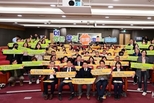
Newsnomics AJAY ANGELINA reporter|
There are suggestions that we should proactively prevent international students from dropping out through academic adaptation programs.
While the government is promoting ‘Study Korea 300K’ with the goal of attracting 300,000 foreign students by 2027, the dropout rate is gradually increasing as the number of international students increases.
On the 1st, the Korea Educational Development Institute (KEDI) released a special plan with this content, ‘Suggestions for a soft landing in attracting new students and foreign students due to the decline in the school-age population,’ in the recently published ‘Education Development 2024 Summer Issue’ on August 1, 2024.
According to KEDI, there is an increase of 83,842 in 2010 to 91,332 in 2015 △153,695 in 2020 △152,281 in 2021 △166,892 in 2022 △2023 The number steadily increased to 181,842 per year in the number of foreign students in degree and non-degree programs in Korea. Last year, the number of international students was approximately 2.2 times than that of 2010.
The number of foreign students by field, the humanities and social sciences field has consistently accounted for about 70% of degree students since 2010. In particular, the demand for science and engineering talent has been rapidly increasing due to the recent development of high-tech industries such as artificial intelligence (AI), but the proportion of international students in engineering and natural sciences has been found to have only been around 20% since 2010.
As per KEDI, the proportion of international students in engineering majors increased from 15.2% in 2010 to 17.4% in 2015, 13.3% in 2020, 13.3% in 2021, 13.7% in 2022, and 15.1% in 2023, not much different for 10 years ago.
The proportion of international students majoring in natural sciences recorded 7.2% in 2010, but decreased to 6.4% in 2023.
As the number of international students increases, the dropout rate is also gradually increasing. The dropout rate of international students at general universities increased from 4.7% in 2010 to 5.7% in 2020, 6.6%, and 7.1% in 2022 and 2023. During the same period, the dropout rate of international students at junior colleges was around 15%. In particular, last year's dropout rate was 14.4%, which was twice as high as that of general universities (7.1%).
Last year, the dropout rate of language trainees at general universities was particularly high at 11.0%.
The dropout rate of degree students was 7.0%. During the same period, at junior colleges, the dropout rates for degree students and language trainees were 16.1% and 10.8%, respectively.
The main reasons for dropping out were issues of maladjustment within the school, financial instability, and language and cultural barriers.
Kim Ji-ha, a researcher at KEDI, said, “International students’ maladjustment on campus is due to the students’ lack of basic academic ability and communication skills, lack of information and support services provided by the university, and lack of awareness of stakeholders within the university.”
“This is why various academic supports from universities and local governments are needed to stably attract foreign students,” Researcher Kim said.
“In addition to the study capacity improvement program for international students at the university headquarters level, we could consider operating a ‘Learning Coordinator System’ at the department level to support the studies of first- and second-year undergraduate students.”
“It is necessary to preemptively prevent dropout by supporting international students’ adaptation to university life and early learning in their major courses,” Kim said.
He also said, “In order for foreign students to adapt and integrate well into the local community, we need to expand their participation in community activities to increase intimacy and sympathy with the local community and create positive learning experiences.”
Last Year, in August, the Ministry of Education announced to increase the number of foreign students to 300,000 by 2027 through the 'Measure to Improve Educational Competitiveness of International Students' (Study Korea 300K Project), raising the share of international students (13th in 2020) to the top 10 in the world.
To this end, the Ministry of Education plans to relax admission requirements for international students and prepare measures to support settlement of international students.










